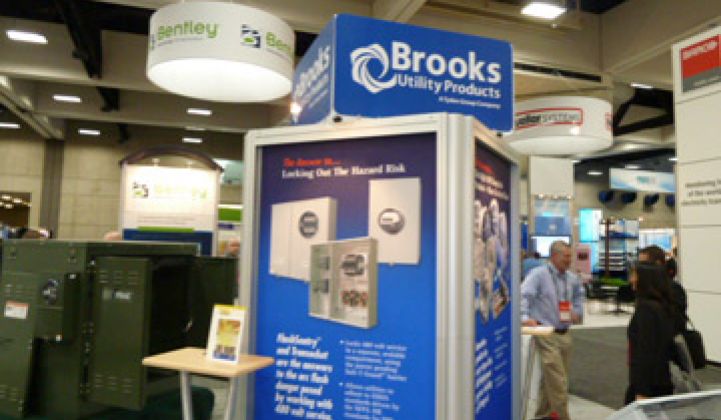One of the big topics at DistribuTECH, the smart grid equipment conference in San Diego, is Cisco, or rather the absence of Cisco.
The networking giant has made it clear that it wants to play prime role in the grid. Last September, it bought Arch Rock, which makes mesh networking equipment for data centers and the grid, and entered into an alliance with Itron.
Since then, silence. Competitors, meanwhile, have continued to announce progress on their smart meter rollouts.
Many believe that further acquisitions will come next. Historically, that’s how Cisco has moved into new markets like commercial W-iFi: it is simply better at buying and integrating new companies than coining new technology in the bowels of their labs.
The potential targets that get the most speculation are Silver Spring Networks and Trilliant. Both have scored large utility deals with their mesh solutions and they don’t have large meter groups (like Itron) that Cisco might want to live without. Silver Spring has won more, which makes it potentially more attractive. Bad blood, however, exists between the two companies, and Silver Spring is gearing up for an IPO, according to sources. It will be expensive.
Trilliant would be less expensive, and it would come with a distribution automation product, the 802.11(a) it got with the acquisition of Sky Pilot. Over 50,000 Sky Pilot units have been planted in the field, said Rob Conant, senior vice president of networking product at Trilliant, in a separate interview. Trilliant, however, wouldn’t deliver the same level of glamor. Cisco would not come into the market as the undisputed leader, which could mean a dent in the public's perception of the company.
Who else? On-Ramp Wireless, Tropos Networks, Arcadian Networks, Echelon, Sensus, and Tantalus Networks could be contenders, but all suffer from the Goldilocks problem of being too small/too big/not quite right.
On other notes:
--All those names above may soon face another problem, too: China. Asian manufacturers are determined to get into grid networking, according to one well-placed source, and companies will soon emerge. Remember Huawei? Many in the early 2000s scoffed that a Chinese company could play a large role in networking.
--On-Ramp Wireless has moved into the increasingly popular market for voltage monitoring. About a month ago, Schweitzer began to integrate On-Ramp’s Ultra Link Processing communication chips into its voltage sensors thereby giving utilities visibility about what is going on out there. It has also started putting its technology into gas meters.
This summer, the company will also come out with a new version of ULP for meters that will cost one-third as much as its current chipset and consume half the power.
“This will take us into metering,” said vice president of strategic marketing Jonas Olsen.
On-Ramp’s selling point is long range with high bandwidth: signals can travel for miles with integrity. In a demonstration, it set up four collectors in San Diego that provide fairly broad coverage over a 1,200-square-mile area. Thirty access points could cover the entire 4,000 square miles of San Diego county, he claimed.
Compare that to mesh: it would take thousands of collectors to do the same job, he asserted.
“We are getting a lot of interest from European water and gas. Their number one complaint with mesh is the unpredictability of network planning,” he said.
--Verizon’s Joe Cappy claimed that utilities have begun to change their attitude toward public carriers. The big problem is operating expense. After building their own smart grid networks, utilities find themselves compelled to hire people to run them. One utility, according to Cappy, had to place 30 employees to run its three different grid networks.
“That’s a heck of an opex,” he said. “Public utility commissions are starting to look at this and starting to fight back.
“These things (private mesh networks) are starting to cost millions of dollars,” he added.
For their part, both Trilliant and Silver Spring execs pointed out that the vast majority of smart grid deals out there revolve around private networks: cellular smart grid networks are still mostly in theory. Still, Cappy has a point: the basic infrastructure exists. LTE will cover over 98 percent of the U.S. by 2013.
Cappy, though, added that public cell carriers will have to work on network quality. Missed calls to meters could quickly clog capacity. “We have to get meter reading into the three, four, and five 9s level,” he said.
Finally, while Verizon will participate in home and building management and demand response, it likely won’t provide these services directly. Instead, the company will serve as the underlying communications layer for a partner.
“I don’t think we will ever become a demand response provider,” he said.
--One major potential innovation for energy efficiency could come in unified billing, says Stephen Smith, director of marketing at Honeywell. ESCOs effectively could put their monthly fees on a utility bill, giving customers complete visibility, as well as the cost-effectiveness of retrofits.
Right now, commercial customers are interested in energy retrofits but often will back away if the payback is longer than six months.



